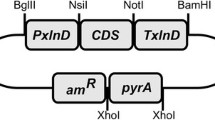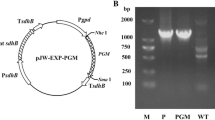Abstract
The synthesis of pectinesterase (PE) and polygalacturonase (PG) by a strain ofAspergillus niger isolated from rotten lemons was repressed by glucose, even in the presence of the inducer. The production of both enzymes started again once the sugar was used up, or when the mycelium was washed free of glucose and incubated in a glucose-free medium containing the inducer; this proved the reversibility of the repression mechanism. The effect of glucose was also tested in the absence of transcription. The results obtained suggest that repression occurs at the translational level.
Similar content being viewed by others
Literature Cited
Brock T (1978) Crecimiento, síntesis macromolecular y differenciación. In: Biología de los microorganismos. 2nd edn. Omega (eds) Casanova, 220, Barcelona, 36, pp 241–242
Cabello VA, Ruiz S, Orihuela AMI (1982) Producción de pectinasas bacterianas utilizando pulpa de café como sustrato. Rev Lat Amer de Microbiol 24:172–179
Egilsson V, Gudnason V, Jonasdottir A, Ingvarsson S, Andresdottir V (1986) Catabolite repressive effects of 5-thiod glucose onSaccharomyces cerevisiae. J Gen Microbiol 132:3309–3313
Hardesty B, Obrig T, Irvin J, Culp W (1973) The effect of sodium fluoride, adenine and cycloheximide on peptide synthesis with reticulocyte ribosomes. In: Kenney FT, Hankalo BA (eds) Gene expression and its regulation, vol 1. New York: Plenum Press, p 377
Hsu E, Vaughn R (1969) Production and catabolite repression of the constitutive polygalacturonic acid transeliminase ofAeromonas liquefaciens. J Bacteriol 98:172–181
Judewicz N, Kornblihtt AR (1983) Transferencia de la información genética y sus mecanismos de control. In: El Ateneo (ed) Bioquímica general de Torres, Carminatti, Cardini, pp 843–844
Kertesz ZI (1955) Pectic enzymes. In: Colowick, Kaplan (eds) Methods in enzymology, vol 1. New York: Academic Press, pp 159–162
Kilian S, Prior B, Latigan P (1983) Diauxic utilization of glucose-cellobiose mixtures byCandida wickeramii. Eur J Appl Microbiol Biotechnol 18:369–373
Maldonado MC, Navarro AR, Callieri DA (1986) Production of pectinases byAspergillus sp. using differently pretreated lemon peel as the carbon source. Biotechnol Lett 8(7):501–504
Maldonado MC, Strasser de Saad AM, Callieri DA (1988) Some regulatory aspects of the synthesis of polygalacturonase and pectinesterase byAspergillus niger sp. Sciences des Aliments, in press
Miller GL (1959) Use of dinitrosalicylic acid acid reagent for determination of reducing sugar. Anal Chem 31:426–428
Shinmyo A, Mitsushima K, Terui G (1972) Kinetics studies on enzyme production by microbes. (IX) Some properties of autoinduction of acid protease inAspergillus niger. J Ferment Technol 50:647–654
Shinmyo A, Davis IK, Nomoto F, Tahara T, Enatsu T (1978) Catabolite repression of hydrolases inAspergillus niger. Eur J Appl Microbiol Biotechnol 5:59–68
Tahara T, Doi S, Shinmyo A, Teuir G (1972). Translational repression in the preferential synthesis of some mold enzymes (1). J Ferment Technol 50:655–661
Author information
Authors and Affiliations
Rights and permissions
About this article
Cite this article
Maldonado, M.C., Strasser de Saad, A.M. & Callieri, D. Catabolite repression of the synthesis of inducible polygalacturonase and pectinesterase byAspergillus niger sp.. Current Microbiology 18, 303–306 (1989). https://doi.org/10.1007/BF01575945
Issue Date:
DOI: https://doi.org/10.1007/BF01575945




